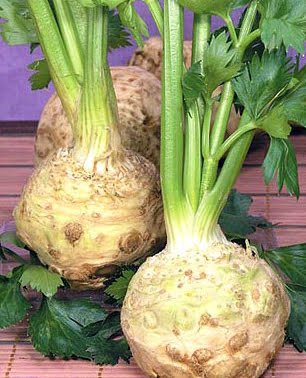Celery and Celeriac [ Apium graveolens ] were bred from the same wild plant. Celeriac grown for it’s swollen stem base or root, is much hardier than stem celery when mature. The availability of self blanching varieties of celery have made the growing of this vegetable much easier for the home gardener. You can still grow ‘trench celery’ from seed, but as it requires a lot more work and attention and takes up more room on the plot, I have concentrated on the ‘self blanching’ types.
Soil Preparation.
Celery and celeriac likes a moisture retentive but well drained soil in a sunny spot in the garden. The addition of well rotted manure or garden compost in the Autum/Winter will help retain the moisture and adding sharp sand will aid drainage of heavy soil. Some of the compact self blanching varieties can be grown in deep pots or tubs of rich compost.
Sowing Celery and Celeriac.
Seeds of both celery and celeriac can be started indoors in March or April. Sow into a pot or small seed tray filled with moist compost. As the celery/celeriac seed is very small, you will only need a pinch. Lightly sprinkle the seed across the surface of the compost and lightly cover with a little vermiculite or sieved compost, being careful not to bury the seed too deeply. Water from the bottom or use a misting spray as it is very easy to disturb the seeds. Place the pots or trays somewhere warm to germinate. Dont let the surface of the compost dry out. Germination can take time and can be erratic especially for celeriac.
Grow on your seedlings with a little heat, protect from cold temperatures as this can cause bolting later on. When the seedlings have their first proper leaves and are large enough to handle, pot on into individual 3 inch pots or into module trays. Keep well watered while growing, but not wet. In May gradually harden off the young plants using a cold frame or a sheltered place in the garden out of direct sunlight. Cover with layers of fleece if cold weather is forcast.
Planting Out: Celery.
Your celery plants should be ready to go out in the garden at the end of May or early June. Plant out in a grid or block rather than in a row, planting 9 inches apart in each direction. Plant the young plants quite deeply, burying the stems up to the base of the leaves. Planting deeply and in blocks will help to ensure pale well blanched stems.
Planting Out: Celeriac.
Your celeriac plants should be ready to plant out at the end of May or early June. Plant out in rows, 12 – 15 inches apart, plant with the base of the seedling at soil level. Covering the new plants with fleece for a few weeks will help to get them established quickly.
Growing: Celery and Celeriac.
Never let your plants dry out. Water well in hot or dry weather. Feeding the growing plants with a high nitrogen fertiliser like Growmore or chicken pellets will improve the crop. If growing celery in pots or large tubs, keep well watered and feed fortnightly with a general liquid feed or a seaweed based one. Mulching celeriac plants will help to retain moisture and suppress weeds. Removing the outer leaves of celeriac as they fade will allow the ‘root’ to develop, also remove any sideshoots that may grow.
Harvesting: Celery.
Celery can be harvested as soon as they are big enough to eat. This is usually from August and will crop through October up till the first frosts. Earthing soil around the celery will help protect the stems from the cold.
Harvesting: Celeriac.
Celeriac roots should be ready to eat from October through till the following March. Once mature the roots will stand a lot of cold and are quite resistant to frost. The roots can either be left in the ground till needed, or lift, twisting off the leaves and store undercover in a greenhouse or shed.
Check out seeds at the Seedparade seed shop.
Varieties: Celery. Golden Self Blanching. Victoria. Celebrity. Ivory Tower.
Varieties: Celeriac. Giant Prague. Monarch. Prinz.
Pests and Diseases. Generally trouble free. Watch out for slugs as they like the crunchy leaves and stems.












